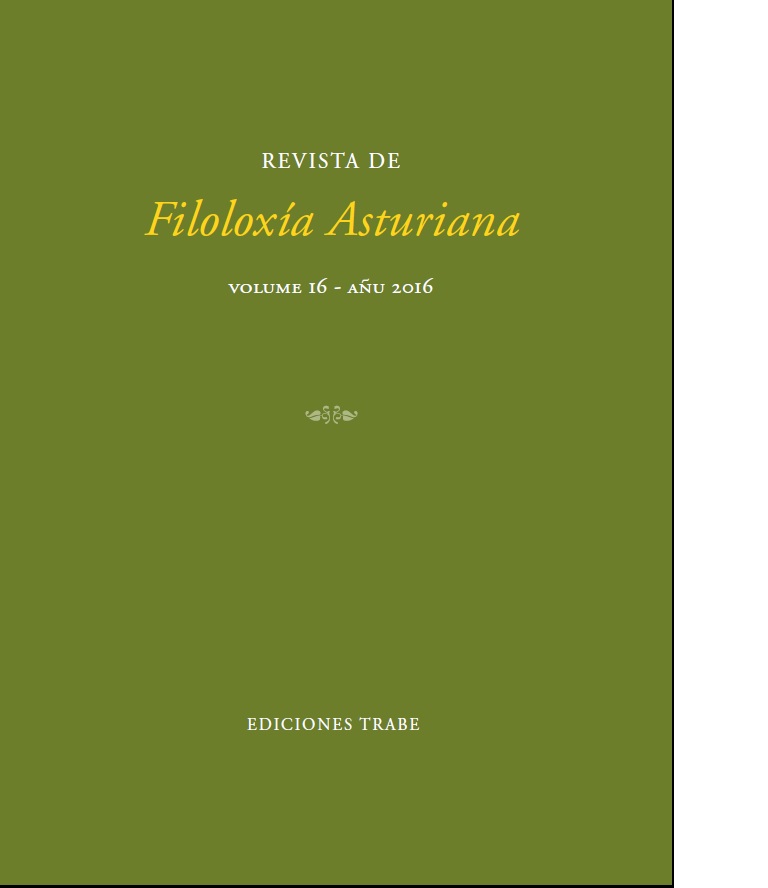Abstract
La lengua asturiana muestra el fenómeno llamado neutro de materia, que se genera cuando un sustantivo incontable precede a un adjetivo neutro, el cual es representado por la terminación -o. Esta estructura crea una lectura genérica; y así, ‘l’arroz blanco’ se refiere a cualquier arroz de ese color. Este adjetivo neutro no se puede manifestar en posición prenominal, porque el resultado sería agramatical. Es decir que el adjetivo prepuesto tiene que concordar en género con el sustantivo, en general para los masculinos la terminación -u, y -a para los femeninos. El ejemplo‘el blancu arroz’ muestra esta concordancia completa del adjetivo prepuesto. Además, el adjetivo pospuesto tiene la opción de generar el neutro, o también concordar con el género del sustantivo que lo precede. Se ve lo segundo en el ejemplo ‘l’arroz blancu’. Los adjetivos antepuesto y pospuesto, los cuales tienen una concordancia completa, conllevan una lectura específica, por la que el hablante se refiere a la realidad que tiene ante sí. Este trabajo pretende examinar la posibilidad de un DegP (Degree Phrase) presente en la estructura sintáctica del asturiano con posibles rasgos de [EPP] y [+ESP(ecificidad)] o solo los de [+ESP(ecificidad)], en
conjunción con movimiento adjetival o sin él, para explicar los contextos en los cuales el neutro de materia no se puede generar gramaticalmente.
The Asturian language demonstrates a phenomena so called the mass neuter. This characteristic of the language contains a mass noun that precedes a neuter adjective, which is represented by the morphological ending -o. This structure creates a generic reading, as the example ‘l’arroz blanco’ is semantically interpreted as any rice that is white. This neuter adjective cannot be in a prenominal position, as this would be ungrammatical. It is to say, that the prenominal adjective must agree in gender with the noun. The adjective is therefore generally marked by the
morphological ending -u and the morphological ending -a is for the feminine one. For example, ‘el blancu arroz’ shows this agreement of the prenominal adjective. In addition to the previously mentioned, the postnominal adjective has the option of either taking on the neuter gender or agreeing with the gender of the noun that precedes it. This is shown with the example ‘l’arroz blancu’. Both the prenominal and postnominal adjective, which have complete gender agreement, cause a specific reading. That is to say that the speaker has the white rice in front
of him. This work aims to examine the possibility of a DegP (Degree Phrase) that is present in the syntactic structure of Asturian, which can contain possible [EPP] and [+ESP(ecificity)] features or only [+ESP(ecificity)] features, in conjunction with adjectival movement or lack thereof, in order to explain the contexts in which the mass neuter cannot appear grammatically.
References
ALLA (Academia de la Llingua Asturiana). (2001). Gramática de la Llingua
Asturiana. Uviéu: Academia de la Llingua Asturiana.
D’Andrés, R. (1993). «Emplegu del neutru n’asturianu. Lletres Asturianes». Lletres Asturianes, 49: páginas 49-84.
D’Andrés, R. (1994). «Aspuetos morfolóxicos del neutru n’asturianu». En Sin fronteras: Homenaje a María Josefa Canellada, páginas 9-30. Madrid: Editorial Complutense.
Arias Cabal, Á. (1998). «Diacronía del incontable o ‘neutro de materia’ en asturiano». En G. Ruffino (ed.), Atti del XXI Congresso Internazionale di Lingüística e Filologia Romanza, I: Sezione 1: Grammatica storica delle lingue romanze, páginas 35-49.
Burner, M. (2015). La sintaxis del neutro de materia en asturiano: Especificidad,genericidad y la posición del adjetivo (tesis de maestría).
Chomsky, N. (1995). The Minimalist Program. Cambridge: MIT Press
Demonte, V. (1999). « A Minimal Account of Spanish Adjective Position and
Interpretation». En Jon Franco (ed.), Grammatical Analyses in Basque and Romance Linguistics, páginas 45-75. Amsterdam: Benjamins.
Fernández Ordóñez, I. (2006). «Del Cantábrico a Toledo: El ‘neutro de materia’ hispánico en un contexto románico y tipológico (primera parte)». Revista de la historia española, 1, páginas 67-118.
Fernández Ordóñez, I. (2007). «El ‘neutro de materia’ en Asturias y Cantabria. Análisis gramatical y nuevos datos». En I. Delgados Cobos y A. Puigvert Ocal (eds.), Ex admiratione et amicitia: Homenaje a Ramón Santiago, páginas 395-434. Madrid:Ediciones del Orto.
Holtus, G. (1992). «Argonesisch/Navarreisisch, Spanisch, Asturianisch/Leonesisch». En G. Holtus, M. Metzeltin y C. Schmitt (eds.), Lexicon der Romanistischen Linguistik, páginas 652-708. Tübingen: Niemeyer.
Pesetsky, D. y Torrego, E. (2000). «T-to-C Movement: Causes and Consequences». En M. Kenstowicz (ed.), Ken Hale: a Life in Language, páginas 1-53. Cambridge:MIT Press.

